There is a theory in Ayurveda pertaining to the very minutest of channels in human body. It is believed that these narrow passageways need to be cleansed on a routine basis.
Panchkarma
Ayurveda emphasizes preventative and healing therapies along with various methods of purification and rejuvenation. Ayurveda is more than a mere healing system; it is a science and art of appropriate living which helps to achieve longevity. It can also guide every individual in the prevention of disease and long term maintenance of health to achieve this balance state of body, mind and consciousness. Ayurveda prescribes Panchakarma therapy for the cleansing of body toxins.
What is Panchkarma?
As the name suggests, Pancha in sanskrit stands for five, karma are the therapeutic measures, therefore Panchkarma means five types of therapeutic considers it necessary before the start of any other therapy. The logic being that permeated with new color, similarly the body needs to be purified before it can be permeated with new colors of youthfulness, health and vigor etc. The Panchkarma therapy of Ayurveda is comprised of basic types of advanced treatment for the evacuation of vitiated dosha (toxic materials) from the body. One can consider this as a body de-tox programme. There are so many subtypes of this therapy and different types of herbal massages, sudations such as Steam, External Oil treatments, Basti (medicated enemas), Virechana (purgation through herbs), Vamana (emesis through herbs), Nasya (nasal administration of oils) etc. are also incorporated. These practices are extremely maintaining and improving physical and mental health.
A) Purvakarma:-
Pre- purification measures for Panchakarma
Before the actual operation of purification begins, there is a need to prepare the body in prescribed methods to encourage the release of toxins. The procedures are Snehana and Sweden.
Snehana:
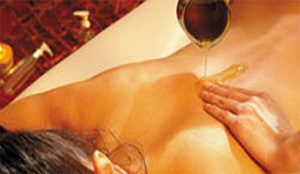 Snehana (Abhyangam) is the oil massage. Oil is applied to the body with a particular type of massage which helps the toxins to move towards the gastro-intestinal tract. Oil massage also makes the superficial and deep tissues soft and supple, thus helping to remove stress and to nourish the nervous system. Snehana is given daily for three to seven days, as indicated.
Snehana (Abhyangam) is the oil massage. Oil is applied to the body with a particular type of massage which helps the toxins to move towards the gastro-intestinal tract. Oil massage also makes the superficial and deep tissues soft and supple, thus helping to remove stress and to nourish the nervous system. Snehana is given daily for three to seven days, as indicated.
Swedenam:
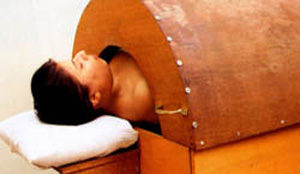 Sweden is sudation or sweating and is given everyday immediately following the Snehana. An herbal concoction may be added to the steam to further loosen the toxins from the individual. Sweden liquefies the toxins and increases the movement of toxins into the gastro-intestinal tract.
Sweden is sudation or sweating and is given everyday immediately following the Snehana. An herbal concoction may be added to the steam to further loosen the toxins from the individual. Sweden liquefies the toxins and increases the movement of toxins into the gastro-intestinal tract.
B) Pradhanakarma:-
Main Purification measures of Panchakarma
Vamana:
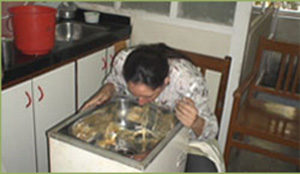 Vamana is a medicated emesis therapy which removes Kapha toxins collected in the body and the respiratory tract. This is given to people with high Kapha imbalance. Daily treatment involves loosening and mobilizing the toxins in an effort to finally eliminate them.
Vamana is a medicated emesis therapy which removes Kapha toxins collected in the body and the respiratory tract. This is given to people with high Kapha imbalance. Daily treatment involves loosening and mobilizing the toxins in an effort to finally eliminate them.
Benefits of Vamana: Bronchial Asthma, Chronic Allergies, Hay Fever, Vitiligo, Psoriasis, Hyperacidity, Chronic Indigestion, Nasal Congestion, Edema, Obesity, Psychological disorders, Skin Disorders etc.
Virechana:
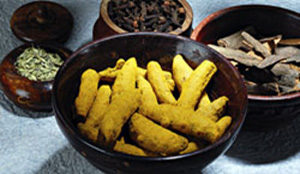 Virechana is medicated purgation therapy which removes Pitta toxins from the body that are accumulated in the liver and gallbladder; it completely cleanses the gastro-intestinal tract. It is a safe procedure without side effects.
Virechana is medicated purgation therapy which removes Pitta toxins from the body that are accumulated in the liver and gallbladder; it completely cleanses the gastro-intestinal tract. It is a safe procedure without side effects.
Benefits of Virechana: Chronic Fever, Diabetes, Asthama, Skin Disorder such as Herpes, Paraplegia, Hemiplegia, Joint disorders, Digestive disorders, Constipation, Hyperacidity, Vitiligo, Psoriasis, Headaches, Elephantiasis and Gynecological disorders.
Basti:
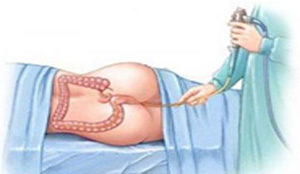 Basti (Enema) is considered as the mother of all Panchkarma treatments since it cleanses the accumulated toxins from all the 3 doshas i.e. Vata, Pitta, Kapha through the colon. Basti is also highly beneficial as a rejuvenating treatment. Sneh Basti (Medicated oil or ghee) and Niruha Basti (Herbal decoction) is given as enema to clean the colon and increase the muscle tone. This procedure is usually applied for 8 to 30 days based on the medical condition of a person.
Basti (Enema) is considered as the mother of all Panchkarma treatments since it cleanses the accumulated toxins from all the 3 doshas i.e. Vata, Pitta, Kapha through the colon. Basti is also highly beneficial as a rejuvenating treatment. Sneh Basti (Medicated oil or ghee) and Niruha Basti (Herbal decoction) is given as enema to clean the colon and increase the muscle tone. This procedure is usually applied for 8 to 30 days based on the medical condition of a person.
Benefits of Basti: Hemiplegia, Paraplegia, Colitis, Convalescence, Cervical Spondylitis, Irritable Bowel Syndrome, Constipation, Digestive disorders, Backache & Sciatica, Hepatomegaly & Splenomegaly, Obesity, Piles, Sexual Debility & Infertility.
Nasya:
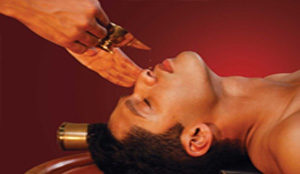 Nasya involves administration of medicated oil through the nose to cleanse accumulated Kapha toxins from the head and neck region. Based on the medical condition of a person, it can be given up to 30 days.
Nasya involves administration of medicated oil through the nose to cleanse accumulated Kapha toxins from the head and neck region. Based on the medical condition of a person, it can be given up to 30 days.
Benefits of Nasya: It include Trigeminal Neuralgia, Bell’s Palsy, improves memory & eye sight, Insomnia, elimination of excess mucus and hyper pigmentation in the face, pre-mature graying of hair, clarity to voice, headaches, Hemiplegia, loss of smell and taste, Frozen Shoulder, Migraine, stiffness of the neck, Nasal Allergies Nasal Polyp, Neurological dysfunctions, Paraplegia, Sinusitis etc.
Raktamokshana :
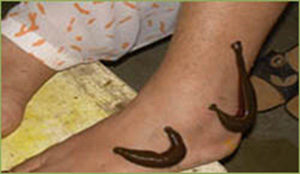 Raktamokshana is one of the Panchakarma Ayurvedic treatments of detoxification. It is made of two words – Rakta i.e. blood and Mokshana i.e to leave and combining both these words makes the word Raktamokshana which means ‘to let out blood’. Raktamokshana is an effective blood purification therapy, in which carefully controlled removal of small quantities of blood is conducted to neutralize accumulated Pitta toxins of many blood borne diseases
Raktamokshana is one of the Panchakarma Ayurvedic treatments of detoxification. It is made of two words – Rakta i.e. blood and Mokshana i.e to leave and combining both these words makes the word Raktamokshana which means ‘to let out blood’. Raktamokshana is an effective blood purification therapy, in which carefully controlled removal of small quantities of blood is conducted to neutralize accumulated Pitta toxins of many blood borne diseases
Benefits of Raktamokshana: This is highly effective in skin diseases like Edema, Abscess, Inflammations, Dullness, Uraemia and Pericarditis.
This five-fold purification system is known as Panchkarma. This loosens and liquefies the doshas, which in turn will then move to the alimentary canal from the periphery of body for elimination.
C) Paschatkarma:-
Post Panchkarma diet regime followed by do and don’ts.
Why Panchkarma?
According to Ayurveda, every human being is a unique phenomenon of cosmic consciousness. The three Dosha (humors) determine every individual’s psychosomatic temperament or constitution. Vata (ether plus air), Pitta (fire plus water) and Kapha (water plus earth) are called the Tridosha, meaning the three Dosha. The internal environment is governed by Vata-Pitta-Kapha(V-P-K), which is constantly reacting to the external environment i.e. the wrong diet, habits, lifestyle, incompatible food combinations (e.g. milk and fish, melons and grain, yogurt and meat or cooked honey etc.), seasonal changes, repressed emotions and stress factors can all act either together or separately to change the balance of V-P-K. According to the nature of cause; Vata, Pitta or Kapha undergo aggravation or derangement that produces Ama. Ayurvedic literature suggests placing the patient on proper diet together with an appropriate lifestyle, habits and exercise and administering a proper cleansing programme such as Panchakarma will lead to healthy mind and body.


